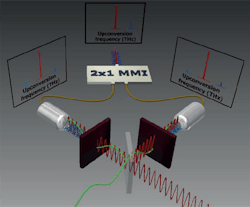Optical single-sideband modulator allows terahertz-rate data transmission over optical fiber
Transmitting data at terahertz frequencies via IR light in optical fibers creates frequency sidebands that interfere with one another, scrambling the signal. However, researchers at Radboud University (Nijmegen, Netherlands) have solved this problem using an optical single-sideband (OSSB) modulator that they developed (shown above), which includes a beamsplitter that splits both IR and terahertz radiation in half.1
In use, a terahertz wave (green) and IR laser light (red) are both split in half by the beamsplitter (gray plane), providing the necessary phase shift of the waves. The laser light is mixed with the terahertz radiation in special crystals (brown planes), and subsequently two sidebands (blue waves) are generated. Both laser light modulations are then coupled by optics in the gray cylinders into optical fiber (tan wires) and combined in a multimode interference (MMI) structure (white MMI plane). The result is that one sideband extinguishes and that the intensity of the other sideband is maximized, solving the problem of terahertz signal distortion in the fiber-optic network.
Because terahertz signals in the air are strongly absorbed by water vapor, wireless terahertz communication can mostly only be used for relatively short distances. However, for high-data-rate applications such as virtual reality, terahertz communication needs to happen over longer distances—which the new OSSB device can facilitate.
Useful for virtual reality
"Our terahertz OSSB modulator allows us to use the existing fiber-optic network," says Afric Meijer, one of the researchers. "Ultra HD and virtual-reality images can be received or transmitted wirelessly through a terahertz link, just like the petabytes of data in research institutes and hospitals."
Source: http://www.ru.nl/english/news-agenda/news/vm/imm/solid-state-physics/2016/terahertz-communication
REFERENCE:
1. A. S. Meijer et al., Nature Photonics (2016); doi: 10.1038/nphoton.2016.182.
About the Author
John Wallace
Senior Technical Editor (1998-2022)
John Wallace was with Laser Focus World for nearly 25 years, retiring in late June 2022. He obtained a bachelor's degree in mechanical engineering and physics at Rutgers University and a master's in optical engineering at the University of Rochester. Before becoming an editor, John worked as an engineer at RCA, Exxon, Eastman Kodak, and GCA Corporation.

